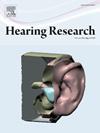Investigating the causal relationship between circulating inflammatory proteins and tinnitus: Insights from a Mendelian Randomization study
IF 2.5
2区 医学
Q1 AUDIOLOGY & SPEECH-LANGUAGE PATHOLOGY
引用次数: 0
Abstract
Tinnitus, a condition characterized by the perception of ringing in the ears, significantly impacts quality of life, yet its underlying biological mechanisms remain poorly understood. Emerging evidence suggests a role for inflammation in tinnitus pathophysiology. This study employs a bidirectional two-sample Mendelian Randomization (MR) approach to investigate the causal relationship between circulating inflammatory proteins and tinnitus. Genetic data from large-scale pQTL and GWAS datasets were analyzed to identify potential causal links. The results reveal that elevated levels of CCL19, CXCL11, and TNFSF12 are positively associated with tinnitus risk, while CD40L and IL-10 exhibit protective effects. Reverse MR analysis suggests that tinnitus may weakly influence levels of Cystatin D, IL-18, and MCP-1, though these associations require further validation. These findings provide novel insights into the inflammatory pathways involved in tinnitus, paving the way for targeted therapeutic strategies and future research into anti-inflammatory interventions.
研究循环炎症蛋白与耳鸣之间的因果关系:来自孟德尔随机研究的见解
耳鸣是一种以耳鸣为特征的疾病,严重影响生活质量,但其潜在的生物学机制尚不清楚。新出现的证据表明炎症在耳鸣病理生理中的作用。本研究采用双向双样本孟德尔随机化(MR)方法来研究循环炎症蛋白与耳鸣之间的因果关系。分析了来自大规模pQTL和GWAS数据集的遗传数据,以确定潜在的因果关系。结果显示,CCL19、CXCL11和TNFSF12水平升高与耳鸣风险呈正相关,而CD40L和IL-10表现出保护作用。反向MR分析表明,耳鸣可能对胱抑素D、IL-18和MCP-1的水平有微弱影响,但这些关联需要进一步验证。这些发现为耳鸣的炎症途径提供了新的见解,为针对性治疗策略和未来抗炎干预研究铺平了道路。
本文章由计算机程序翻译,如有差异,请以英文原文为准。
求助全文
约1分钟内获得全文
求助全文
来源期刊

Hearing Research
医学-耳鼻喉科学
CiteScore
5.30
自引率
14.30%
发文量
163
审稿时长
75 days
期刊介绍:
The aim of the journal is to provide a forum for papers concerned with basic peripheral and central auditory mechanisms. Emphasis is on experimental and clinical studies, but theoretical and methodological papers will also be considered. The journal publishes original research papers, review and mini- review articles, rapid communications, method/protocol and perspective articles.
Papers submitted should deal with auditory anatomy, physiology, psychophysics, imaging, modeling and behavioural studies in animals and humans, as well as hearing aids and cochlear implants. Papers dealing with the vestibular system are also considered for publication. Papers on comparative aspects of hearing and on effects of drugs and environmental contaminants on hearing function will also be considered. Clinical papers will be accepted when they contribute to the understanding of normal and pathological hearing functions.
 求助内容:
求助内容: 应助结果提醒方式:
应助结果提醒方式:


